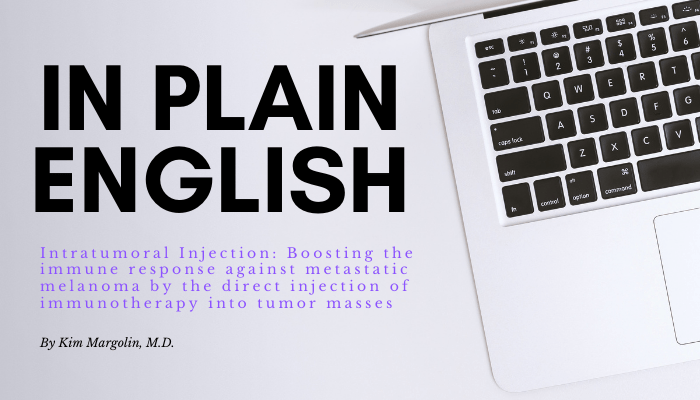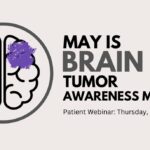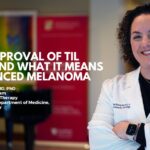
Por Kim Margolin, M.D.
Using the patient’s own immune system to combat melanoma is a powerful tool for patients with metastases—those whose melanoma has recurred or spread to a different part of the body from where it originally arose. Over half of patients can now experience remissions (reduction of the size of some or all tumors and relief of symptoms) with best available therapy. About 70% of remissions—about 40% of all patients—are long-lasting and may be cures. These remission rates are a phenomenal improvement on the dismal statistics we experienced in melanoma less than ten years ago.
Unfortunately, the other 60% of patients experience failure to achieve remission, or they relapse—meaning the melanoma returns in the same or new locations. For these patients, subsequent treatment rarely provides a remission or long-term control. (The exception is patients whose tumor has a BRAF mutation, since the oral BRAF drugs have a high remission rate, though the remissions are often short-duration. For more on this topic, see the In Plain English from November, 2020.) Much research is focused on trying to find out why the 60% fail immunotherapy and what treatments might help them.
One of the most important obstacles to the success of systemic immunotherapy (treatment given by a route that delivers the active agent to all parts of the body, such as intravenously) is the composition of the tumor and associated non-tumor tissue. In addition to cancerous tissue, tumor masses also contain blood vessels and connective tissues—the cells that support the structure of the body’s organs, which can also promote tumor growth and spread. Researchers have learned that cancer cells’ genes and proteins and those of other cells in the local tumor environment determine the outcome of immunotherapy.
The two opposite ends of the cancer-immunity spectrum are often described as “type 2” and “type 1” immune responses, when describing the cells and other components of the microscopic tumor environment. Type 2 immune responses tend to be pro-tumor and anti-immune—thus a tumor can appear to be filled with killer T lymphocytes, but those cells are actually type 2 and don’t kill tumors. Type 1 refers to characteristics that are more pro-immune and anti-tumor, where the T lymphocytes are killers and produce substances that enhance the immune response. Most tumors, including over half of melanomas, lean more toward type 2 than type 1 immune response characteristics, and even potent immunotherapies are insufficient to convert them to a type 1, immunoresponsive pattern. Tumors that are filled with T lymphocytes and certain surface proteins that reflect an active immune response (one important one is called PD-L1) are also termed “hot”, while those that have very few lymphocytes, either at the edges (immune excluded) or completely absent (immune desert) are considered “cold,” or lacking in the ability to respond to immunotherapy. The driving force underlying the development of better immunotherapy regimens for melanoma and also across the cancer spectrum is the identification of which patients have cold tumors unlikely to respond to the best available therapy.
For those patients as well as for those who initially respond but later relapse, we need treatments that will make cold tumors hot and reverse their resistance to immunotherapy. There are many potential ways to achieve that goal, one of which is to administer immune-stimulating drugs directly into the tumor to induce an intense local immune response. After a few words about side effects of routine immunotherapy in the next paragraph, we will discuss the concepts and current status of intratumoral immunotherapy.
In addition to the desire to enhance antitumor immunity by turning cold tumors hot using local therapy, it is also important to limit the side effects and risks associated with systemic therapy. Remember that systemic treatment circulates through the bloodstream and thus distributes the treatment through the whole body, so side effects may occur in all organs. Immunotherapy’s toxicities result from the brisk activation of the immune system that results in autoimmune damage to normal organs, such as the skin (rash), the intestine (diarrhea, sometimes very severe), the thyroid and other hormone-producing glands (requiring medicine supplements), the liver (requiring steroid therapy and sometimes more aggressive immune suppression) and many other organs. Because they occur via the same biological mechanism—a brisk activation of the immune system—there is a positive association between getting into remission and getting side effects. Because the side effects are often treated with immunosuppressive drugs, there is always concern that those drugs will increase the patient’s risk of infection or shorten the duration of the remission. The occurrence of serious side effects also complicates decisions about resuming the systemic immunotherapy.
Now turning to our discussion of intratumoral therapies, one relatively new method of turning cold tumors hot is to inject them with inflammatory or immunostimulatory substances that trigger the entry of large numbers of killer T lymphocytes and other immune cells, resulting in the production in the tumor environment of the pro-immune/anti-tumor substances described earlier. When tumor cells die, they also release additional inflammatory substances and antigens (material that is unique to the tumor and recognized as foreign, leading to the attack of tumor by immune cells) that trigger even more T lymphocytes to recognize foreign substances on tumor cells. Because these killer T lymphocytes readily re-circulate through the lymph canals (tiny, invisible routes that parallel the veins and carry liquid and cells of the immune system) and the blood, these killer T cells can reach other tumor sites as well as microscopic tumor seeds that are also in circulation, thus controlling tumor growth at other locations in the body, beyond the injected tumor mass. This method is generally called intratumoral injection.
The major goal of combining intratumoral injection therapies with systemic agents is to increase the rate of remission into the same range—or higher—than what is achieved by giving two different systemic immunotherapies. Remember, a key question that researchers are asking through clinical trials is: Does this treatment work better than the best treatment we already have? If yes, continued research is absolutely warranted, and potentially FDA approval will be sought if the treatment is also safe. If no, continued research may still be warranted, if there is reason to believe that the type of treatment shows enough promise.
While remission rates are definitely increased, sometimes nearly doubled, with two different systemic immunotherapies, the toxicities resulting from so much stimulation of the immune system can be severe and even fatal, and they require complex management with immunosuppressive drugs as detailed above. Immunotherapy often needs to be stopped early when these toxicities occur, which makes the management even more complicated. Thus, the second but equally important goal of combination intratumoral and systemic immunotherapy is to achieve the increased remission rate at the cost of much less toxicity than with doublets of systemic immunotherapy.
Several types of immunotherapy have been injected directly into tumor masses of melanoma patients in clinical trials, and melanoma is the only type of cancer for which the Food and Drug Administration has already approved a drug to be given intratumorally (by injection into the tumor). This drug, called Imlygic (the generic name is TVEC, an abbreviation for talimogene laherparepvec), is a member of a new class of treatments broadly called oncolytic virotherapies, because they break up cancer (oncolytic) and they are based on viruses that have been genetically engineered in the majority of cases. TVEC consists of a common herpes simplex virus that has been genetically modified to disable its ability to cause infections and increase the ability to grow in tumor cells. In addition, a gene for GM-CSF—a mild immunostimulant—has been inserted into the virus.
In the clinical trial that led to TVEC’s approval, about half of the patients had a remission in the injected mass(es), 25% had an overall remission that included uninjected tumors, and 16% had remissions that lasted at least six months. While this level of activity is modest, it proved that local intratumoral injections could induce remission by enhancing the local immune environment of melanoma metastases AND also resulted in circulating immune responses that controlled tumors at a distance from the injected ones. There is now another modified herpes virus, RP-1, in clinical studies for melanoma and other cancers. RP-1 is also being combined with intravenous cemiplimab (Libtayo), a PD-1 blocking antibody approved for advanced squamous cancer of the skin.
While the use of intratumoral injection therapy appears to work in a way that is complementary to other forms of immunotherapy, it is necessary to study the safety and activity of combinations before using them in patients. For example, TVEC was added to pembrolizumab (Keytruda), and the combination appeared to have a much higher remission rate than expected from either drug alone. A randomized trial was then completed—pembrolizumab with TVEC or with placebo; this trial is necessary because many immunotherapy side effects are subtle and may also occur in patients not getting the active drug. The results of that trial are expected in mid-2021. Other novel approaches with TVEC include its use in neo-adjuvant therapy, to shrink tumors prior to surgical removal or to prevent the need for surgery. (For more detail on neo-adjuvant strategies, please see In Plain English from December, 2020.) The safety and efficacy of injecting melanoma metastases that are deep inside the body such as in the liver, lungs, or internal lymph nodes, is also being studied.
In addition to the herpesvirus-derived oncolytic virotherapies described above, several others are also in development for melanoma and other tumors, derived from a wide variety of viruses with different properties and different engineered features. Viruses can also be used to deliver genetic material into tumors, which can then produce a new immunostimulatory substance that promotes antitumor immunity.
The second most common type of intratumoral therapy, using substances that are less complex than the oncolytic virotherapies discussed above, emerged from growing understanding of the immune system’s response against infection; they are generally called Toll receptor agonists or TLR agonists (or ligands, meaning a substance that sticks to a receptor on or inside cells and transmits a signal that directs the cell to change in some way). There are several TLR ligands that are naturally found in the surface wall and the DNA inside bacterial cells. When bacteria enter the body, these substances bind to very specific receptors on immune “educator” cells called dendritic cells, triggering inflammatory signals that provide immediate protection against such microbes—but without immunologic memory (this immediate response is called the innate immune system). These signals also promote the cascade of immune reactions that lead to the activation of our adaptive immune system, which takes longer to develop but involves antigen recognition and the development of immune memory responses (with long-lasting immunity, like vaccines). There are currently three Toll receptors that are the major focus of drug development—TLR4, TLR7/8, and TLR9.
TLR9 agonists are the most extensively studied and consist of a sequence of DNA with unique structure due to its bacterial derivation. Several different TLR9 agonists have been synthesized from the known sequence of these fragments in bacteria and have been packaged into particles that can be safely injected into tumor masses. Side effects have been very modest, consisting of inflammatory flu-like symptoms that reflect immune system stimulation. When given with PD-1 antibodies, no enhancement of toxicities occurs. So far, each of the drugs in this class has shown antitumor activity and is now in combinations with systemically-administered immune checkpoint blocking antibodies. CMP-001 is the first TLR9 agonist to show substantial activity, particularly in combination with pembrolizumab, where it has provided remissions in patients whose melanoma grew on pembrolizumab alone. Randomized trials are planned to study the optimal use of this combination. Two other TLR9 agonists that appear promising are tilsotolimod, which is also under investigation, and SD101, which is another experimental TLR. Both of these have already shown antitumor activity in melanoma and are likely to have their best activity in combination with immune checkpoint antibodies such as one of the PD-1 blocking agents mentioned above or ipilimumab (Yervoy).
Therapeutic cytokines—proteins produced by cells of the immune system that mediate communication with other immune system cells—comprise the third type of intratumoral immunotherapy for melanoma, again more likely to be used in combination with systemic therapy than given alone. While certain cytokines, such as alpha-interferon and interleukin-2, have been used for intratumoral injection since the 1980s, their use was based on less rigorous evaluation and without formal studies, dose-response evaluation, microscopic analysis of tumors, or sophisticated immunologic studies such as we now perform in parallel with clinical testing. Thus, no standard cytokine therapy for intratumoral injection was ever approved or adequately validated, and researchers are working to evaluate their efficacy now.
The potential of interleukin-12, a very important cytokine that mediates many of the same activities triggered by the TLR agonists described above, has recently been explored. Since IL-12 is too toxic and short-lived to be given as a systemic immunotherapy, it was developed into a form of gene therapy to be given intratumorally, in this case by initial injection followed by using a tiny brief electrical current that facilitates tumor uptake and production of IL-12—a process called electroporation. Preliminary studies showed intratumoral IL-12 gene therapy has activity not only against the injected mass but also against uninjected tumors in other areas in the body. Like the agents discussed above, optimal use of intratumoral IL-12 gene delivery, now known as tavokinogene telseplasmid or “tavo,” is likely to be in combination with a PD-1-blocking antibody. This process of initial injection of IL-12, followed by electroporation, is currently being studied in combination with pembrolizumab in patients with advanced melanoma whose tumors have grown despite prior PD-1 blocking treatment, and randomized studies of pembrolizumab with or without tavo are in development.
In summary, intratumoral injection—the boosting of the immune response against metastatic melanoma by the direct injection of immunotherapy into tumor masses—is a promising treatment method because it’s effective AND it seems to cause fewer toxicities for the patient than combination systemic immunotherapy. One treatment, called TVEC, is an oncolytic virotherapy that has already been approved by the FDA for use in melanoma, and it has seen success. Clinical trials are underway for two other types of intratumoral therapy that have shown substantial promise in preliminary studies, Toll receptor agonists and therapeutic cytokines.

Kim Margolin, M.D.
El Dr. Margolin es un médico oncólogo especializado en melanoma y otros cánceres de piel. Trabajó en City of Hope durante 30 años y también ocupó puestos en la facultad de la Seattle Cancer Care Alliance/Universidad de Washington y en la Universidad de Stanford. Entre sus logros académicos se encuentran el liderazgo a largo plazo del Grupo de Trabajo de Citoquinas, la participación en la Red de Ensayos de Inmunoterapia del Cáncer, la participación en el Comité de Melanoma del Grupo de Oncología del Suroeste y numerosos cargos en la Sociedad Americana de Oncología Clínica y la Sociedad de Inmunoterapia del Cáncer. La Dra. Margolin ha revisado subvenciones para muchas organizaciones sin ánimo de lucro relacionadas con el cáncer y agencias gubernamentales. También ha sido miembro del Comité Asesor de Medicamentos Oncológicos de la FDA, del comité de certificación de Oncología Médica de la Junta Americana de Medicina Interna y del Comité Asesor Científico de la Organización Europea para la Investigación y el Tratamiento del Cáncer.
El Dr. Margolin colabora con AIM en Melanoma para escribir la publicación mensual "in Plain English" con el fin de proporcionar actualizaciones oportunas sobre los nuevos avances para los pacientes, cuidadores y otras personas con interés en los avances médicos en el melanoma.
Entradas recientes

Navigating the Journey Together – Conversations with Melanoma Caregivers

May is Brain Tumor Awareness Month

President’s Letter | April 2024

Celebrating a Milestone: 20 Years of the Dallas Steps Against Melanoma Walk

